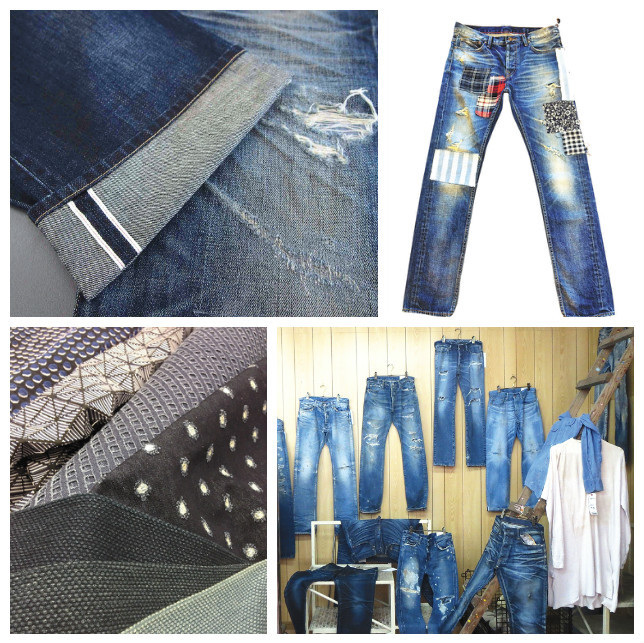New expressions created through needle-punch and synthetic fibres
Japanese denim is renowned worldwide for its longevity and excellent quality. The beautifully faded colours, unique texture, and vintage feel particular to Japanese selvedge denim is valued highly by a wide range of jeans apparel manufacturers. The Japanese denim industry is also characterised by its continuous material development in the realms of processing technology, weaves, and the innovative use of raw materials.
The Kaihara Corporation, Japan’s largest denim manufacturer, enjoys strong sales from its lines of functional denims produced using synthetic fibres such as superfine polyester. The company’s trademark material is its MOTION FIT DENIM, which boasts a powdery texture and the ability to stretch for the wearer’s comfort.
This soft and easy-to-wear material was developed in 2011 in collaboration with leading synthetic fibre manufacturer TORAY INDUSTRIES INC. Ongoing improvements to the material’s texture have since contributed toward its success as a best seller.
Narrow-width vintage denim, produced using shuttle looms, is another of the Kaihara Corporation’s strengths. Reproducing vintage machinery and slowly weaving the denim results in a fabric with the warm texture unique to materials produced by shuttle looms. The company has also achieved the beautifully faded colours of vintage denim through careful selection of the cotton wool blend and a special dyeing process.
Richness in variation is another characteristic of Japanese denim. YAGI TSUSHO LIMITED, an influential Japanese trading company, will launch a wide variety of denim and indigo materials at textile trade fair Milano Unica. In addition to its classic denim, which received broad acclaim at the most recent Milano Unica, the company also boasts a strong offering of specially-processed products.
Damage treatment, starting from the fabric phase
The main feature of the new denim is the damage treatment. This does not mean the material is simply torn and distressed. Rather, damage treatment is carried out from the fabric phase onwards in order to create patterns within the damaged fabric itself.
For example, prints on the reverse side of the denim can be brought into relief through the use of needle-punch techniques, and then finished to create checked patterns or even patterns that resemble snakeskin leather.
Damage treatment can also be carried out in circular shapes in order to create a dotted pattern. These techniques fuse ideas and technology to create new denim materials. Other innovative design methods include the use of opal processing to create three-dimensional plaid patterns on denim, as well as the use of sashiko needlework.
High-quality fabric is being produced through collaboration between companies in production areas throughout Japan, such as the processing of Okayama denim in Gifu or Kyoto. This superb quality is one of the reasons behind Japanese fabric’s high appraisal among buyers.
Jeans made completely in Japan, from the production of the fabric to its processing and sewing, were on display at the previous Milano Unica, where they were particularly well-received. Even greater effort will be put into pushing sales of Japanese denim going forward.
Starting this year, Japan’s leading spinning company, KURABO INDUSTRIES LTD., will launch KURABO DENIM PRIME BLUE, its own value-added denim line.
As befits a spinning company, KURABO focuses on the threads used in the creation of its products, and has enhanced its material development through collaboration with companies in production areas across Japan. The company aims to strengthen its appeal to luxury denim brands in the future.
Japanese companies have also adopted a proactive stance toward the development of new technologies in the denim washing process, which plays an important part in determining the final appearance of the product.
Environmentally friendly
Based in the production area of Kojima, leading processing company HOWA Corporation was an early adopter of environmentally friendly technologies. In 2002, it harnessed the power of ozone to develop Air Wash technology, which enables the bleaching of fabrics without the use of an effluent.
The company has incorporated a ‘Laser Processing’ method since 2006 to enhance the faded, vintage tones of denim materials. The method uses a laser to lightly burn the surface of the fabric, achieving an aged impression indistinguishable from that of material produced through conventional processing methods. The technology has received acclaim among major jeans manufacturers in Japan.
HOWA Corporation installed two new laser-processing machines at its home plant in December of last year, expanding its production system to include a total of six machines.
Recently it has also taken on initiatives to develop an image-processing technology to work in conjunction with the laser-processing machines, aiming to enable the production of even more precise and detailed designs.
The company is also bringing its laser-processing and ozone-bleaching machines to HOWA Denim-Tech, a Los Angeles-located denim washing and processing plant acquired by HOWA in 2012.
Acting as a base for the production of Japanese-quality denim in the United States, HOWA Denim-Tech has maintained full operations while keeping its focus on attracting influential jeans brands on the West Coast.





